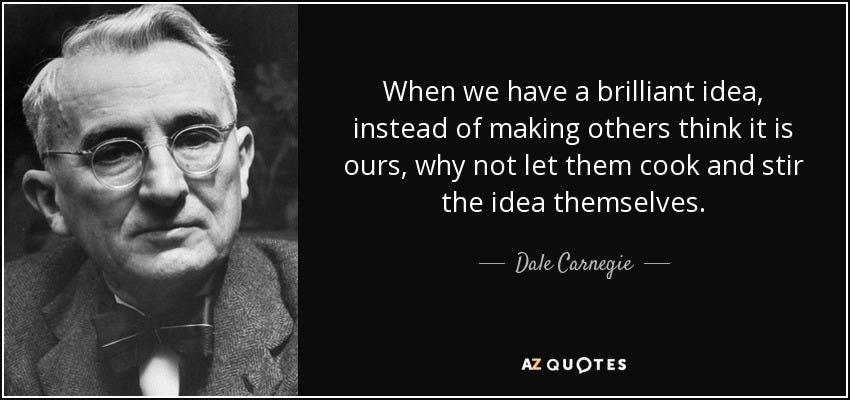One of the best leadership techniques: making people believe your idea was theirs.
It doesn’t matter who gets the credit (especially you). All that matters is getting to the right decision.
Early on in my business career, I learned how difficult it is to say “no” to people. Actually, let me clarify: it’s not hard to say no to people, but it is difficult to deal with the fallout from telling someone no.
Our brains are wired to believe that our beliefs are correct, and also to be socially accepted by those around us. Being told no, or being told our idea is incorrect, threatens both of those. All of us, at some time, have witnessed a colleague react horrifically when they were told no, or when they were told they had to do something that they didn’t agree with. It’s not fun – but as a leader, we often have to make these hard decisions.

A way around this is to make people believe that your idea was actually theirs. This isn’t a matter of forcing your idea onto others. Rather, it’s a matter of getting someone to think the way you are, and seeing if they get to that same conclusion. If they don’t, then perhaps your idea wasn’t correct in the first place. But oftentimes, someone fails to agree with an idea because they’re only looking at it from their own perspective.
You know how the book is always better than the movie? There’s a psychological reason for that. When we read, our brains create. Our minds build the world that the book itself has presented, and we forever believe that our mental image is correct. When the movie comes out, we’re seeing a director’s mental image of that same book, and it rarely matches ours. It’s the ultimate form of confirmation bias – we have a belief that the book looks this way, and the movie is that way. When two ideas collide, the one in our own head wins.
Which is why it’s so difficult when you want to suggest an idea, or try something new, and the person who has to actually implement it is putting up a roadblock. Their mental image of the situation is different from yours, so the pushback is not just natural – it’s what has helped us survive as a species over millennia.
Ultimately, you need to get someone thinking about a problem in the same way as you, so that they can get to the same place you did on their own. Here are a few tips of how to get there:
Use the Socratic method of questioning
Asking someone questions is a much better method than trying to convince them of something. If you tell someone “this is how it should be,” their first response will likely be defensiveness. If you ask open-ended questions, however, they are much more likely to ponder the situation and consider different options. It’s a typical tactic lawyers use every day. You also may want to start with the end goal and work backwards. Why aren’t we at that place right now? What are some options to try to fix that issue? Is there something we need to purchase to make it better? Do we have the solution here already? You know where you’re trying to get to at the end of the day – but you need your colleague to get there as well.
“Yes and”
While this is actually a technique used for improv comedy, there is plenty of research showing that the use of the word “and” instead of “but” makes life much easier. If your colleague expresses an opinion that you disagree with, don’t say “Yeah, but…”, as that will cause defensiveness from the other side. Tell them, “Yeah, and…” Your idea will still come across, but in a way that will lessen the chances of the other person closing off their mind to an alternative opinion. It shows you’ve heard them and are taking their opinion into account when presenting your own.
Know Your Audience
More than likely, you know your colleagues quite well, especially if you’ve worked with them for a long time. You know their strengths, weaknesses, personality flaws, and how they best operate. Utilize this knowledge to frame your argument in a way that will give you the best chance of success. If you know one of their biggest concerns is their workload, try to ask questions that help them see how the change will ultimately make their life easier in the long-term. If their concerns tend to be about making a wrong decision, ease their mind by reminding them that mistakes are how we learn and improve. Use your knowledge of them to your benefit, by framing issues in a way that they will care the most about.
Don’t take credit. Ever.
Being a business leader is not an ego-boosting activity. I’ve written about this ad nauseum, but it can never be said enough. As a business leader, you should care about only one thing: is it good for the company? If the answer is yes, then nothing else should matter. If your colleague’s “idea” is actually yours, you shouldn’t care about claiming credit for it. You should only care that it gets implemented. That internal satisfaction should be plenty. If you’re looking for external praise or external motivation, you should get out of business right away. As Winston Churchill once said, “Neither look for nor expect gratitude but rather get whatever comfort you can out of the belief that your effort is constructive in purpose.”
Perhaps the biggest key to this entire strategy is to make sure you’re not over-using it, or that you’re using it for miniscule issues. Utilizing this strategy to convince someone that they should take out the trash is a recipe for disaster. But if you’re looking to improve a larger part of the business with bigger ideas, especially if you want to try some different things to see how they work, I highly recommend making others think that they’re the ones who came up with the idea in the first place. Not only does it get them on board with what you are ultimately trying to achieve, but they end up much more enthusiastic and energetic upon implementation.


